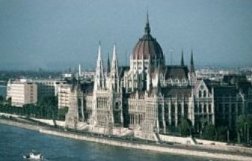
Huibs' UrbLogL'équipe Regenera à Budapest a parcouru l'ancien ghetto de la ville, dont les habitants d'origine ont disparus à la façon qu'on connaît. Ils ont été remplacés par des Tziganes, des Roma, venus d'autres quartiers de la ville, de la campagne et, dernièrement, immigrés de la Roumanie, de la Slovaquie, de l'Ukraine et de la Bulgarie. Sur les populations Roma de l'Europe de l'Est, nous reviendrons bientôt ailleurs.

Mais l'émancipation de la nombreuse population juive de Budapest avait, avant 1944, projeté leur majorité dans d'autres quartiers de la ville, où l'on vivait, pêle-mêle, en tant qu'ouvrier, commerçant, scientifique ou artiste. Les juifs se comprenaient comme membres d'une vaste communauté culturelle allemande. Goethe était pour eux, ce que Shakespeare est pour Philip Roth. L'éveil, depuis la fin du dix-neuvième siècle, d'un nationalisme culturel hongrois (la "magyarisation") les avait amenés, en grand nombre à adopter des noms de famille hongrois, c'est vrai, mais néanmoins ils ont continué à se voir comme appartenant à une plus vaste communauté culturelle et intellectuelle, dont l'Hongrie constituait une des sub-entités.
La capacité à se sentir chez soi dans plusieurs identités et à plusieurs niveaux (famille, quartier, ville, pays, etc.) est de plus en plus demandée aux citoyens d'un Europe condamné à s'unir à s'ouvrir au monde. Mais c'est mal vu. Avant la guerre, c'était le "cosmopolitisme" juif, ou "intellectuel" qui servait comme signe de Kaïn. Actuellement, c'est plutôt le "multiculturalisme" ou le "relativisme culturel" qui sont bannis du "politiquement correct".
Quoi qu'il en soit, vers 1947-1948 le nouveau pouvoir communiste en Hongrie, reprena ce thème de la condamnation du "cosmopolitisme" pour se débarrasser de ses leaders et de ses membres influents juifs. Ce qui provoqua une nouvelle émigration des juifs qui avaient survécu les déportations nazies de 1944. Pendant le long régime relativement libéral de Janós Kádár après 1956, la situation s'améliorait, mais le changement de régime de 1990 libéra à nouveau l'antisémitisme dormant, surtout, mais pas exclusivement, à droite.
Notre groupe, en sortant du quartier de Magdolna, est passé devant la grande synagogue de style orientalisant, brillamment restaurée: la plus grande de l'Europe centrale. Mais elle n'est pas le lieu accueillant qui animerait le retour des juifs hongrois, éparpillés dans le monde. On a adopté, ou mieux: inséré, intégré, de nouvelles identités dans la collection des anciennes. Un retour définitif reste exceptionnel.
Pourtant, les retours sur l'histoire, les retours qui aident à mieux faire le deuil des "chez-soi" perdus, ces retours-ci sont nombreux. Le compte-rendu, en annexe, du livre "Retours. Journal de Budapest" par Susan Rubin Sulaiman, en témoigne. Il est de la main de Corinne Gere, fille d'émigrés juifs hongrois de 1947, vivant en Belgique.
 Ce qui importe pour les professionnels de l'émancipation urbaine, c'est de voir que la ville n'a pas seulement un étendu horizontal, dans l'espace, mais qu'elle a aussi une autre dimension, "verticale", celle de son histoire, de son mélange unique de communautés. Les morts, les émigrés, les bannis y appartiennent autant que les vivants, les immigrés et les jeunes. Le regard des communautés disparues contribue à la façon dont l'émancipation des nouveaux-venus se déroule. Il existent quelques éléments pour un deuil créatif, libérateur.
Ce qui importe pour les professionnels de l'émancipation urbaine, c'est de voir que la ville n'a pas seulement un étendu horizontal, dans l'espace, mais qu'elle a aussi une autre dimension, "verticale", celle de son histoire, de son mélange unique de communautés. Les morts, les émigrés, les bannis y appartiennent autant que les vivants, les immigrés et les jeunes. Le regard des communautés disparues contribue à la façon dont l'émancipation des nouveaux-venus se déroule. Il existent quelques éléments pour un deuil créatif, libérateur.
Ce qui nous ramène aux Roma. Un éternel retour, lui aussi...
 Huib
Huib  01-05-2006
01-05-2006 
 [EN]
[EN] [FR]
[FR] [DE]
[DE]









I walked out with a much better picture of what might have happened. Looking at the inside of real flight decks, real air traffic control centers, looking at real people doing the same things to start that morning they did every other morning is illuminating, quietly and effectively. Good use of the tools of film-making.